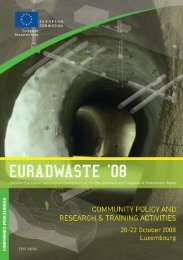EU industrial structure - EU Bookshop - Europa
EU industrial structure - EU Bookshop - Europa
EU industrial structure - EU Bookshop - Europa
You also want an ePaper? Increase the reach of your titles
YUMPU automatically turns print PDFs into web optimized ePapers that Google loves.
Ireland also has a high RCA in computer and information<br />
services, together with Finland. US service industries<br />
have comparative advantage in financial services and in<br />
trade with personal, cultural and recreational services.<br />
Japanese service industries have comparative advantages<br />
in construction services, as do China and Russia. India is<br />
highly specialised in computer and information services.<br />
China differs from India in this respect. While China has<br />
strong comparative advantages in manufacturing radios,<br />
televisions and telecommunication equipment, it does<br />
not have any advantage in the services related to those<br />
manufacturing goods. Brazil has comparative advantages<br />
in other business services.<br />
Increased internationalisation of <strong>EU</strong><br />
industries<br />
The globalisation of economic activity shows itself not<br />
only in increased trade but also in increased foreign direct<br />
investment (FDI) which has displayed higher growth<br />
than trade for at least the last 15 years. The stocks of<br />
both inward and outward <strong>EU</strong> FDI are concentrated in the<br />
financial and real estate sectors. In absolute terms, financial<br />
Executive summary<br />
intermediation, real estate and business activities represent<br />
almost two thirds of the overall outward <strong>EU</strong> FDI stock and<br />
more than two thirds of the inward <strong>EU</strong> stock of foreign<br />
direct investment<br />
Globalisation also has an impact on corporate research,<br />
development and innovation (R&D&I). Internationalisation<br />
of R&D has increased considerably in the <strong>EU</strong>. The share of<br />
foreign owned patent applications in the <strong>EU</strong> increased from<br />
some 10 % in 1990 to 17 % in 2007. The largest increase<br />
has been recorded by intra‑<strong>EU</strong> patent applications. The<br />
most internationalised manufacturing industries in terms<br />
of foreign‑owned patents in the <strong>EU</strong>‑27 are manufacture of<br />
radio, TV and communication equipment, food and drink,<br />
office machinery and chemicals. Outward patenting and<br />
R&D outside the own country is still relatively modest.<br />
On average, only 10 % of all <strong>EU</strong>‑27 patents were granted<br />
abroad between 2003 and 2007 at the same level as US<br />
patents while BRIC countries had a larger share of outward<br />
patenting. The US is the most important location for <strong>EU</strong><br />
outward R&D. The US accounts for 60 % of overseas patents<br />
applied by <strong>EU</strong> entities at the EPO. The BRIC share is still small<br />
but rising fast and is now larger than the Japanese share of<br />
<strong>EU</strong> outward patenting.<br />
11
















